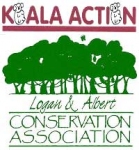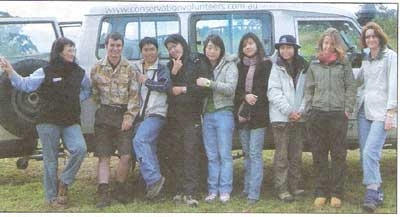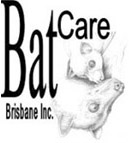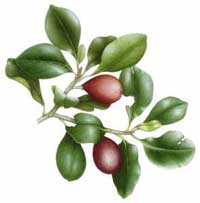
Logan and Albert Conservation Association

 Premier The Honourable Anna Bligh, and Minister for Sustainability, Climate Change and Innovation The Honourable Andrew McNamara released a joint statement Wednesday 5 August 2008. It reads
Premier The Honourable Anna Bligh, and Minister for Sustainability, Climate Change and Innovation The Honourable Andrew McNamara released a joint statement Wednesday 5 August 2008. It reads
are among options to be considered as the Bligh Government confronts a crisis facing koalas in southeast Queensland.
Premier Anna Bligh said new research showed the population of koalas in the wild was directly linked to the animals' movement through urban areas and urgent action was needed to slow the dramatic mortality rate.
This information has come to light since the introduction in 2006 of the Government's Koala Plan and means more radical moves are needed to stop the extinction of koalas in SEQ.
A collection of photos taken during the second week of the revegetation project. The group continued to clear grass from around the existing plants, move mulch into haystack size piles and cut back the lantana. Week 3 photo gallery is here. | {gallery}week2:::1{/gallery} |
Hon Andrew McNamara MP Minister for Sustainability, Climate Change and Innovation says in the foreword:
The policy establishes a framework for using environmental offsets in Queensland. It provides principles and guidelines for applying and developing more detailed ‘specific-issue' offsets policies for important environmental values such as vegetation and fish habitat. Environmental impacts from development must first be avoided and if not avoidable then minimised. Environmental offsets may be used to counterbalance any
remaining loss of environmental values. The policy will ensure that offsets are used consistently and transparently across the State, as a last line of environmental preservation response. The full document can be read here.
 All levels of government need to place more value on conserving koalas and their essential habitat now in order for the koala species to survive in Australia. Dr Hanger from the Wildlife Hospital Australia reports on the latest findings of a study University of Queensland have conducted the past year following the progress of 10 koalas which, up until their release, had never lived independently. This story is available from Sunshine Coast Daily Online. Read it here.
All levels of government need to place more value on conserving koalas and their essential habitat now in order for the koala species to survive in Australia. Dr Hanger from the Wildlife Hospital Australia reports on the latest findings of a study University of Queensland have conducted the past year following the progress of 10 koalas which, up until their release, had never lived independently. This story is available from Sunshine Coast Daily Online. Read it here.
The Australian Koala Foundation and other conservation groups are very concerned about the longterm survival of the koala - our national icon. AKF called for an overhaul of the 1998 National Koala Strategy because it has "not helped the koalas" with over 25 000 recorded koala deaths since its inception. The media release is available here. Australian Koala Foundation also has an enewsletter which can be accessed from the same page.
Koala Campaigners is a recent strategy led by the Australian Koala Foundation to help you help the koala.
 A TEAM of international young volunteers from Hong Kong, Germany, Korea, Taiwan, UK and Belgium has arrived for the next phase of the "Rescue Action for the Veresdale Scrub" managed by the Logan and Albert Conservation Association (LACA). The team of seven young people and team leader Myrium De Rignies has been provided by Conservation Volunteer Australia to help LACA on the Bilarabyn Reserve site at Veresdale. The one per cent of the remaining areas of the Veresdale Scrub stretch across the Scenic Rim and Logan City Councils from Gleneagle to Cedar Vale.
A TEAM of international young volunteers from Hong Kong, Germany, Korea, Taiwan, UK and Belgium has arrived for the next phase of the "Rescue Action for the Veresdale Scrub" managed by the Logan and Albert Conservation Association (LACA). The team of seven young people and team leader Myrium De Rignies has been provided by Conservation Volunteer Australia to help LACA on the Bilarabyn Reserve site at Veresdale. The one per cent of the remaining areas of the Veresdale Scrub stretch across the Scenic Rim and Logan City Councils from Gleneagle to Cedar Vale.
Team leader Myrium De Rignies (left) with the LACA volunteers about to tackle rescue action at Veresdale Scrub with project leader Carla Parker on the right.
 The Minister for the Environment, Heritage and the Arts has formulated a proposal under Part 13A of the Environment Protection and Biodiversity Conservation Act 1999 (EPBC Act) to amend the List of Specimens taken to be Suitable for Live Import . A draft assessment report has been prepared by the Department of the Environment, Water, Heritage and the Arts (DEWHA) against the terms of reference approved by the Minister. The draft report assesses the suitability of import of the Savannah Cat into Australia. Comments were invited on the draft report for 20 business days, closed on 17 July 2008.
The Minister for the Environment, Heritage and the Arts has formulated a proposal under Part 13A of the Environment Protection and Biodiversity Conservation Act 1999 (EPBC Act) to amend the List of Specimens taken to be Suitable for Live Import . A draft assessment report has been prepared by the Department of the Environment, Water, Heritage and the Arts (DEWHA) against the terms of reference approved by the Minister. The draft report assesses the suitability of import of the Savannah Cat into Australia. Comments were invited on the draft report for 20 business days, closed on 17 July 2008.
Savannah cats, which can weigh more than 13kg, are described in the report as ''the result of selective breeding to establish desirable features (eg: large ears or wild-looking colouration and patterns) or temperament suitable for demand of the companion cat market''.
Mr Garrett said the report suggested the potential breeding in of wildcat genes to the existing feral cat population could lead to even more killing of Australian native animals. Savannah cats are a cross between a serval, which is an African wildcat, and a domestic cat and they can grow much larger than normal domestic cats. This report notes that there is potential for these cats to adapt to the Australian environment. Estimates suggest there could already be up to 12 million feral cats across Australia and they are already one of the single biggest killers of Australian native animals. The report also suggests that the potential breeding-in of wildcat genes to existing feral cat populations could see them develop even better hunting skills.
The minister said he would not hesitate to use his powers to prohibit the importation of the cats ''if it is necessary to protect the environment''.
Mr Garrett has allowed 20 working days for comment on the draft report.
WPSQ has made a submission to the federal government commenting the proposal to amend the List of Specimens Taken to be Suitable for Live Import (Live Import List) urging a ban on the import of savannah cats. WPSQ is urging a blanket change to the legislation that defines all 5th generation hybrids as domestic.
Visit the web page Savannah cats: the case against importation to read more about this issue.
RSPCA Australia has commented that allowing Savannah cats, which are currently classed as domesticated after five generations of breeding from their wild ancestors, into Australia would be a huge mistake.
Australian veterinarians have also commented strongly against the importation of more wild-domestic pet hybrids like the savannah cats currently in quarantine.
The report Draft environmental assessment of the suitability of the import of the Savannah Cat (Domestic Cat x Serval hybrid specimens) into Australia 19 June 2008 is available online here.
Comments received and any relevant additional information provided will be considered by DEWHA in finalising the assessment report.
Submissions should be in writing and sent to
Director
Exotic Species Regulation Section
Wildlife Branch
Department of the Environment, Water, Heritage and the Arts
GPO Box 787
CANBERRA ACT 2601
or to
This email address is being protected from spambots. You need JavaScript enabled to view it.
Australian wildlife is already endangered by many threats - habitat clearing, climate change, introduced feral animals.
Senator Christine Milne from the Green presented a petition to the federal government 26 June 2008. This is available in Hansard. This petition can be accessed here. This was begun by an online herpetology discussion group.
The University of Sydney's professor of ecology, Chris Dickman, is warning these hybrid cats would be uncontrollable in Australia. "It hasn't come in through the usual quarantine processes or risk assessments that would otherwise need to be done." Forty of the nation's leading feral animal researchers are calling for urgent changes to prevent hybrid supercats from being imported into Australia.
The Australian environment is suffering from the humble domestic cat gone feral. Imagine the carnage from a bigger stronger feral cat bred from an already wild animal.
For more coverage on this topic see news from Invasive Animals Cooperative Research Centre's CEO Tony Peacock at this site and petitions both for and against importation.
Information on the damage feral cats are currently doing is provided at this cat facts page.
Help stop the importation of hybrid cats such as "Savannah cats"! Please participate by signing the petition and let the Honorable Peter Garret, Minister for Environment, Heritage and The Arts and the Senate know that these hybrid killing machines don't belong here or comment on the draft report by 17 July 2008.
An African Serval is the most efficient wild cat hunter in Africa. Australia's quarantine regulations make it legal for a cat that is only five generations away from a purebred serval to come into the country. In a 2007 paper in Science, Carlos Driscoll of Oxford University showed that domestication of the cat probably began 12,000 years ago and was completed 8,000 years ago. New designer breeds of cat didn't exist 25 years ago.
Keeping your cat inside or in a cattery - see more here and here - will keep your pet safe and also protect our wildlife.
 The Rescue Helpline is available for bat rescue advice and assistance. The Helpline services the Greater Brisbane Area, taking in Brisbane, Ipswich, Logan, Redlands and Pine Rivers.
The Rescue Helpline is available for bat rescue advice and assistance. The Helpline services the Greater Brisbane Area, taking in Brisbane, Ipswich, Logan, Redlands and Pine Rivers.
The Helpline is staffed by local volunteers, who have been trained in Bat rescue, care and rehabilitation. It is an EPA requirement that all bat hanlders be vaccinated against Australian Bat Lyssavirus (ABL). All of our volunteers have been appropriately vaccinated.
Rescue Mobile - 24 hr service - 0488 228 134
Bat Information Help Line ph : (07) 3321 1229
.rescue.education.conservation.habitat.
 ENDANGERED REGIONAL ECOSYTEM is threatened by subdivision and development application being assessed under out of date planning documents. A copy of this planning scheme is available on Logan's website here. It is a pdf file of 171 pages. It was first published 9 February 1985. The Beaudesert Shire Planning Scheme 2007 (commenced 30 March 2007) can be accessed from this webpage.
ENDANGERED REGIONAL ECOSYTEM is threatened by subdivision and development application being assessed under out of date planning documents. A copy of this planning scheme is available on Logan's website here. It is a pdf file of 171 pages. It was first published 9 February 1985. The Beaudesert Shire Planning Scheme 2007 (commenced 30 March 2007) can be accessed from this webpage.
 Write a letter to the editor of your local paper to help make the Government feel the pressure to endorse Garnaut's recommendations and get the positive aspects of the report heard. The Government are currently considering the Garnaut Report but it is the polluters' voices who are being heard in the media.
Write a letter to the editor of your local paper to help make the Government feel the pressure to endorse Garnaut's recommendations and get the positive aspects of the report heard. The Government are currently considering the Garnaut Report but it is the polluters' voices who are being heard in the media.
GetUp! have provided a handy tool to help to write to the paper of your choice. There is a Climate Solutions Info Sheet with the key findings of the Garnaut Review. Read that Info Sheet here. Go to this campaign page.
 Bilarabyn Reserve is the area where Logan and Albert Conservation Association is working in partnership with Scenic Rim Regional Council natural resource management staff, and other, non government organisations, to revegetate a large parcel of land to restore the dry vine scrub rain forest that existed pre farming activities.
Bilarabyn Reserve is the area where Logan and Albert Conservation Association is working in partnership with Scenic Rim Regional Council natural resource management staff, and other, non government organisations, to revegetate a large parcel of land to restore the dry vine scrub rain forest that existed pre farming activities.
Carla Parker is the Project Officer managing and coordinating work teams and volunteers. Botanical expertise is provided by Janet Hauser who is also a talented botanical artist who co-authored with Jan Blok, and illustrated Fragments of Green: An Identification Field Guide for Rainforest Plants of the Greater Brisbane Region to the Border Ranges. Andy Grodecki is co-manager and our natural resource management guru.
Our partner groups will use our documentation and maps to guide their onground work. These documents can be viewed  Bilarabyn Reserve Managment Plan July 2008
Bilarabyn Reserve Managment Plan July 2008  Bilarabyn Reserve Revegetation Management Plan map
Bilarabyn Reserve Revegetation Management Plan map